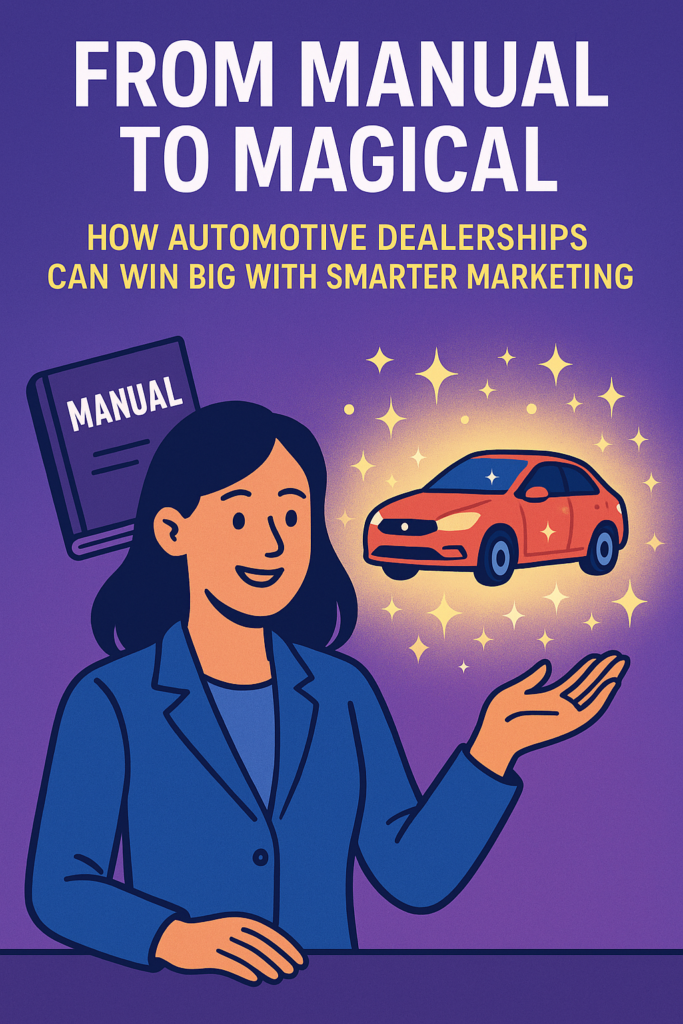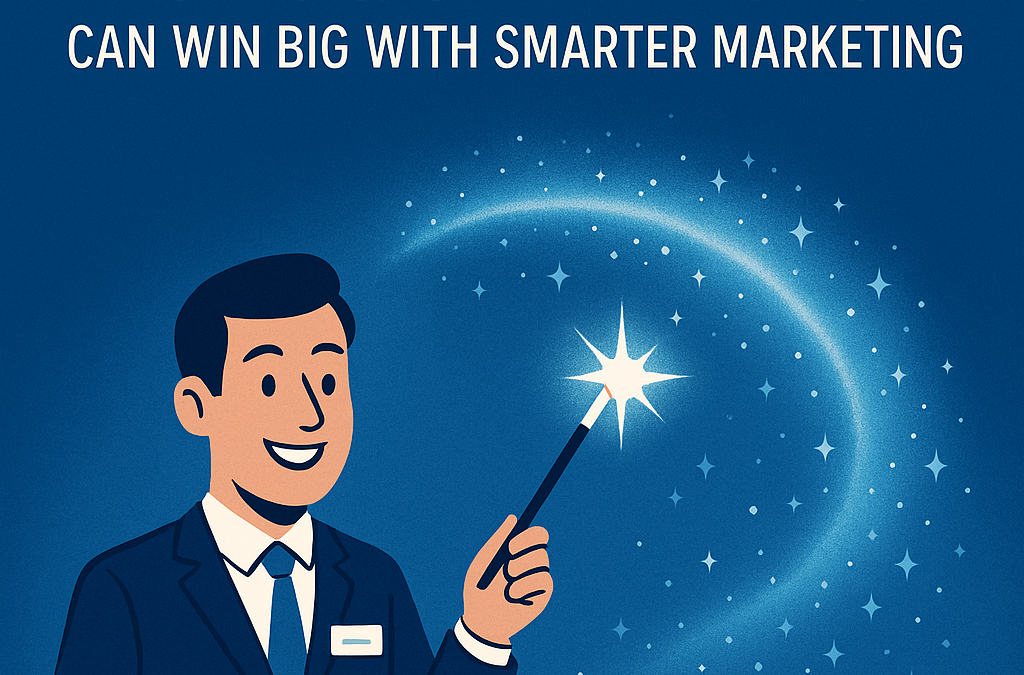In today’s ultra-competitive automotive world, the difference between a thriving dealership and one that’s just scraping by often comes down to one thing: smart marketing. Let’s face it — the old, manual methods of promoting cars aren’t cutting it anymore. If your marketing strategy feels more like turning a rusty crank than flipping a switch, it’s time for a change.
So how do you take your dealership marketing from tedious to transformational? In this guide, we’ll explore how to trade guesswork for data, flyers for funnels, and one-size-fits-all blasts for personalized, automated magic. Think of it like upgrading from a bicycle to a Ferrari — same journey, radically different ride.

The Evolution of Dealership Marketing
There was a time when newspaper ads and radio spots ruled the day. Then came TV, then the internet, and now — we’re deep in the era of hyper-targeted digital marketing. What worked five years ago might not even make a dent today.
Marketing directors who are still relying heavily on print or untargeted email blasts are missing out on vast pools of data-driven insights and automation tools that their competitors are using to win more leads and close more deals.
2. Why Manual Marketing is Holding You Back
Let’s be real — manual marketing is exhausting. It’s slow, inefficient, and leaves too much room for error. Creating each email from scratch? Updating spreadsheets for customer follow-ups? Sound familiar?
This approach is like washing cars by hand when you’ve got a drive-through system just sitting there. Smart marketing isn’t about working harder. It’s about working smarter.
3. The Role of Technology in Modern Dealership Marketing
From CRMs to automation platforms, technology is no longer a luxury — it’s a lifeline. Tools like HubSpot, Salesforce, or DealerSocket help streamline efforts and ensure you’re sending the right message to the right person at the right time.
Modern marketing tech helps you automate repetitive tasks, track lead behavior, and generate reports that actually tell a story — not just a pile of numbers.
4. Understanding Your Audience: The Power of Buyer Personas
Who exactly are you marketing to? First-time buyers? Families? Car enthusiasts?
Creating buyer personas helps you tailor your message for different segments of your audience. Imagine trying to sell a sports car the same way you sell a minivan — not gonna work.
When you understand your audience, you speak their language. And when you speak their language, they listen.
5. Personalization at Scale: Turning Data into Delight
One-size-fits-all marketing is out. Personalization is in.
Using customer data — like search history, previous visits, or cars they’ve test-driven — you can create tailored messages that feel like they were made just for them. It’s like getting a birthday card with your name on it vs. “Dear Valued Customer.”
And yes, this can be done at scale with the right tools.
6. Marketing Automation: Your 24/7 Sales Assistant
Imagine having a marketing assistant who never sleeps, never takes breaks, and follows up with leads the moment they engage. Sounds magical? That’s marketing automation.
You can set up automated email sequences, reminders for sales reps, and even re-engagement campaigns for cold leads. It saves time, reduces human error, and keeps your sales pipeline full.
7. Social Media: More Than Just Pretty Pictures
Yes, that Instagram post of a shiny new car gets likes — but likes don’t sell cars. The trick is using social media to drive traffic, nurture leads, and build trust.
Run contests, share customer stories, use video walkarounds, and promote service specials. Platforms like Facebook even allow you to target by income, location, and car preferences.
It’s not just social. It’s strategic.
8. Email Marketing: Still a Heavy Hitter
Email might seem old-school, but it remains one of the highest ROI tools in dealership marketing.
But it only works if done right. That means:
- Segmented lists
- Compelling subject lines
- Mobile-friendly templates
- Clear calls to action
Don’t just promote — educate and engage.
9. SEO and Local Search: Get Found Before They Walk In
Google is the new front door. If you’re not showing up on page one when someone searches “dealership near me” or “best SUV deals,” you’re invisible.
Invest in:
- Local SEO (Google Business Profile)
- Keyword-rich website content
- Positive reviews and reputation management
Your website should be more than a digital brochure. It should pull people in.
10. PPC Campaigns: Precision Targeting That Pays Off
Pay-per-click ads aren’t just for the big guys. Even smaller dealerships can get major results — if campaigns are set up smartly.
You can:
- Target by ZIP code
- Use retargeting for website visitors
- Promote time-sensitive offers
Think of PPC as laser-focused marketing — zeroing in on hot prospects with dollars that go further.
11. Video Marketing: Bringing Showroom Vibes to Screens
People love watching videos. Why not bring your showroom experience to them?
Ideas include:
- Virtual test drives
- Behind-the-scenes tours
- Customer testimonials
- Service tips
Video content builds trust and helps humanize your brand.
12. CRM Integration: Where Sales and Marketing Shake Hands
Marketing generates the lead, sales closes it — but what connects the dots?
A well-integrated CRM system ensures no lead falls through the cracks. It keeps customer data centralized, accessible, and actionable.
Sales teams love it because they know what the customer has seen. Marketing loves it because they get feedback on what’s working.
Win-win.
13. Measuring What Matters: KPIs for Smart Dealers
You can’t improve what you don’t measure.
Track:
- Cost per lead
- Conversion rates
- Email open/click rates
- Website traffic sources
- Ad spend ROI
Focus on actionable metrics, not vanity ones. A thousand followers mean nothing if they don’t convert.
14. Success Story Snapshot: A Dealership That Did It Right
Take “Maple Auto Group” — a mid-sized dealership that ditched flyers for Facebook ads, replaced manual emails with HubSpot sequences, and implemented a CRM sync.
In six months, they saw:
- 40% more qualified leads
- 25% higher close rate
- 2x engagement on social
The takeaway? Smart marketing isn’t optional — it’s essential.
15. Final Thoughts: Start Small, Think Big
Feeling overwhelmed? Don’t be.
Start with one or two strategies — maybe automating email follow-ups or boosting your Google profile — and build from there.
The key is progress, not perfection. Every small improvement brings you closer to marketing magic.

